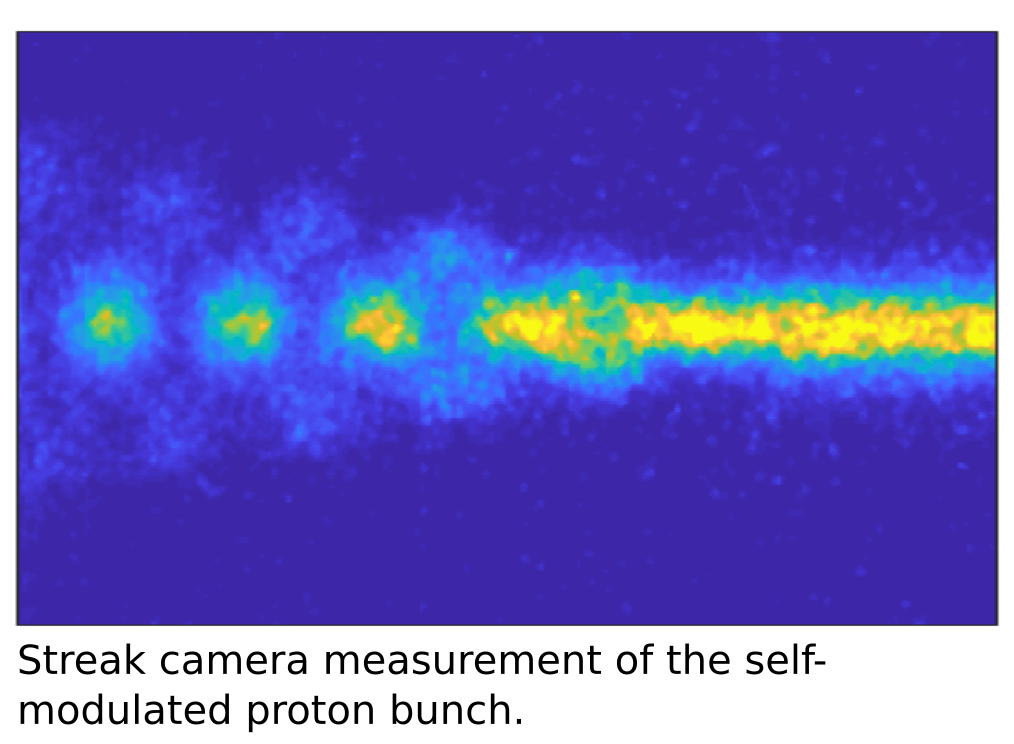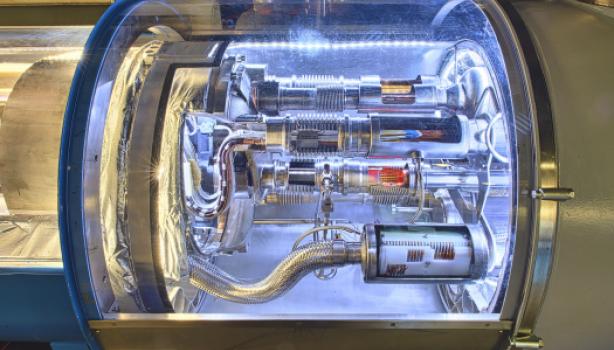Small proton bundles are needed to separate the charges in the plasma, thus creating surfable waves for the electrons.
Plasma wakefield acceleration technology has the potential to revolutionize linear lepton colliders. Plasma can sustain accelerating fields that are many orders of magnitude higher than the fields of conventional radio-frequency cavities. Thus, plasma-based acceleration could substantially decrease the length (and possibly cost) of a future linear accelerator.
Plasma wakefields can be excited by a highly relativistic particle bunch, the so-called drive bunch. As the bunch enters the plasma, plasma electrons respond to its electric field and start oscillating at the plasma frequency; their oscillations sustain the wakefield. The wakefield’s longitudinal and transverse components accelerate and focus a witness bunch. Similar to a surfer on a water-wave, the witness bunch gains energy from the wakefield.
The drive bunch excites large-amplitude plasma wakefields, when it is about one plasma wavelength long (typically < 3 mm) and its density similar to the plasma electron density (> 1014/cm3). Such short dense particle bunches are available at facilities such as SLAC, but their energy content is small (<100 J) and when exciting wakefields, their energy depletes over a short distance.
Proton bunches at CERN carry much larger amounts of energy, in excess of 10 kJ. This is enough to drive several GV/m field amplitudes over hundreds of meters. Unfortunately, their bunch length is on the order of 6-12 cm, at least 20 times too long. Additionally, their particle density is approximately 10-100 times too low.
The AWAKE experiment at CERN recently demonstrated for the first time that - using the seeded self-modulation process - one can use those long proton bunches to excite high amplitude wakefields. As the long bunch enters the plasma, it drives low amplitude seed wakefields (~10 MV/m). The transverse wakefields act back on the bunch and periodically focus and defocus it. Defocused protons leave the bunch. After all defocused protons have left, focused regions form a train of ‘micro-bunches’. Each micro-bunch drives its own wakefield and these fields add resonantly, resulting in a large amplitude wave.

Figure 1. As the long bunch enters the plasma, it drives low amplitude seed wakefields (~10 MV/m). (Image: AWAKE)
The plasma itself modulates the proton bunch. Thus, micro-bunches are spaced at the plasma wavelength. This is a fundamental physics property of the process. AWAKE measured the proton micro-bunch structure using a streak camera with pico-second time resolution and showed directly that the self-modulation occurs. Measurements of the micro-bunch spacing (or frequency) are in good agreement with the theoretically predicted value for various plasma densities.

Figure 2. Streak camera measurement of the self-modulated proton bunch. (Image: AWAKE)
Further, AWAKE measured the transverse deflection of the protons that were defocused during the self-modulation process on a screen after the plasma exit. It was shown that such a large transverse displacement can only be achieved if the transverse wakefield amplitudes exceed the amplitude driven by the unmodulated proton bunch. This proves that – as expected - the wakefields have grown along the bunch. Time-resolved measurements of the defocused protons confirm that the displacement of the defocused protons increases along the bunch.
This is clear evidence of proton bunch self-modulation and excitation of high amplitude wakefields in plasma. AWAKE also accelerated externally injected ~18 MeV witness electrons to 2 GeV in these wakefields as published in a Nature article last year. The longitudinal wakefield amplitude reached values comparable to the transverse one. All physics concepts required for proton-driven wakefield acceleration have now been validated, paving the way for more in-detailed studies.
The path to a plasma-based collider is still long as there are many challenges that need to be overcome. But the outstanding success of this proof-of-principle experiment now opens the door for further breakthroughs: demonstration of good witness bunch quality after acceleration, scalability of the plasma and acceleration process and very high witness electron bunch energy. These will the primary goals of AWAKE Run 2 which will start in 2021.
Further information:
- Experimental Observation of Plasma Wakefield Growth Driven by the Seeded Self-Modulation of a Proton Bunch, M. Turner et al. (AWAKE Collaboration); Phys. Rev. Lett. 122, 054801 (2019), https://journals.aps.org/prl/abstract/10.1103/PhysRevLett.122.054801
- Experimental Observation of Proton Bunch Modulation in a Plasma at Varying Plasma Densities, AWAKE Collaboration; Phys. Rev. Lett. 122, 054802 (2019), https://journals.aps.org/prl/abstract/10.1103/PhysRevLett.122.054802


